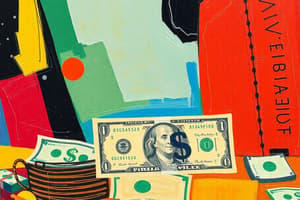Podcast
Questions and Answers
What is the primary focus of Unit 3?
What is the primary focus of Unit 3?
- Role of Central Banking
- Supply of Money (correct)
- Interest Rates
- Inflation and its causes
Which of the following topics is covered in Unit 4?
Which of the following topics is covered in Unit 4?
- Supply of Money
- Deflation (correct)
- Monetary Policy
- Central Banking
What aspect of interest rates is addressed in Unit 4.1?
What aspect of interest rates is addressed in Unit 4.1?
- Central bank strategies
- Deflation objectives
- Determinants and measures of interest rates (correct)
- Causes of inflation
What is the main topic of Unit 5?
What is the main topic of Unit 5?
Which unit covers the causes and effects of inflation?
Which unit covers the causes and effects of inflation?
What section in Unit 4 is dedicated to price measurement?
What section in Unit 4 is dedicated to price measurement?
In the context of monetary policy, what does Unit 5.2 focus on?
In the context of monetary policy, what does Unit 5.2 focus on?
Which section would you find information about central banking's role?
Which section would you find information about central banking's role?
What is one key function of money as outlined in the course outcomes?
What is one key function of money as outlined in the course outcomes?
Which of the following theories explains the relationship between money supply and interest rates?
Which of the following theories explains the relationship between money supply and interest rates?
Which measure is used to assess money supply in an economy?
Which measure is used to assess money supply in an economy?
What can be considered as 'black money'?
What can be considered as 'black money'?
Which of the following best describes the IS-LM model?
Which of the following best describes the IS-LM model?
What is a primary concern of monetary policy?
What is a primary concern of monetary policy?
Which theory is associated with the demand for money, suggesting that money is held for transactions and precautionary reasons?
Which theory is associated with the demand for money, suggesting that money is held for transactions and precautionary reasons?
What does the modern currency system primarily include?
What does the modern currency system primarily include?
Flashcards are hidden until you start studying
Study Notes
Theory of Money
- This course explores the concept and evolution of money from ancient to modern times.
- Focuses on the relationship between money, interest, and prices.
- Understands the functions of money and its different types.
- The course analyzes theories of demand for money including the Keynesian, IS-LM, Friedman, and Tobin's Portfolio approach.
- Covers the concepts of money supply, measures, and its relation to interest rates.
- Examines the role and objectives of monetary policy, including the influence of central banking.
Introduction
- The course begins with an overview of the modern currency system and the concept of black money.
- It also explores the evolution of Indian coinage and currency systems.
- Examines the concept of money as a means of wealth creation.
Demand for Money
- This unit focuses on the different theories of demand for money.
- The course explores the Keynesian theory that posits that the demand for money is influenced by the transaction motive, the precautionary motive, and the speculative motive.
- Explores the IS-LM model which illustrates the relationship between the interest rate and the quantity of money demanded.
- Examines the Friedman's theory which introduces the concept of the "permanent income" in the demand for money.
- The unit also explores the Tobin's Portfolio approach, which sees the demand for money as part of a wider portfolio of assets.
Supply of Money
- This unit outlines the various tools used to measure the supply of money and the factors that influence it.
- Understanding the relationship between money supply and interest rate is crucial in this section.
Money, Prices and Interest
- Key concepts like interest rates, determinants, and measures are explored here.
- The unit also examines the measurement of price changes and the impact of inflation and deflation on the economy.
- Covers methods for measuring inflation and the effects of deflation.
Monetary Policy
- The role of central banking and the objectives of monetary policy are examined in this section.
- Explores the key functions of central banking in managing the money supply and maintaining financial stability.
- Examines the objectives of monetary policy in controlling inflation, promoting economic growth, and maintaining stable exchange rates.
Studying That Suits You
Use AI to generate personalized quizzes and flashcards to suit your learning preferences.




